NREL Researchers Traveled the Southwest To See the Future of Transportation in Action
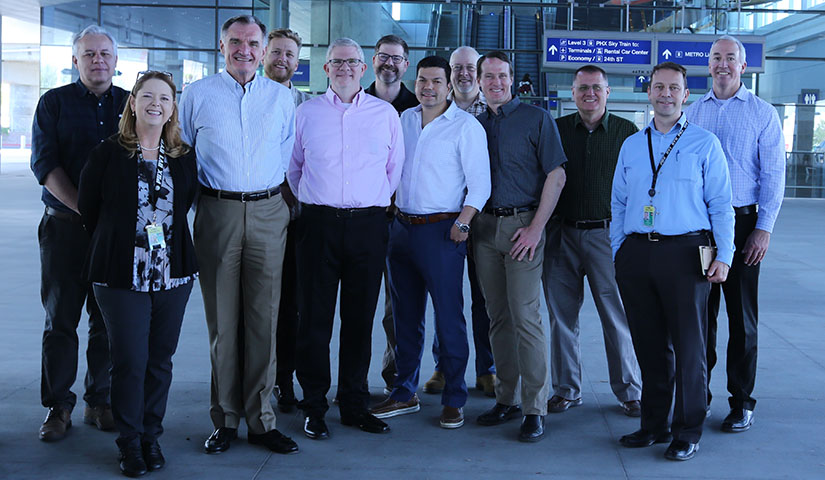
Imagine this: You fly into Phoenix late, long after most people are in bed. You stroll outside, suitcase in tow, and a sleek white car glides up to the curb to meet you. It is 100% electric and totally autonomous. There is no driver behind the wheel and no safety attendant on board—just you, the car, and a smooth ride across the city that takes you wherever you want to go.
Sound futuristic?
The future, it turns out, is already here.
Electric, driverless, on-demand travel can sound like science fiction. But this kind of forward-looking transportation is already being woven into emerging mobility options across the country.
While not every example is as flashy as the electric “robotaxis” cruising around Phoenix, Arizona, each one represents a step closer to the future of sustainable transportation—one that aims to be more energy-efficient, less expensive, and more widely accessible than transportation today.
To see these technologies in action, researchers from the National Renewable Energy Laboratory (NREL), technology managers from the U.S. Department of Energy, and leaders in the transportation technology space spent three days touring innovative mobility systems across the Southwest. Here is what they learned.
For over four decades, citizens of Arlington, Texas, have voted against using taxpayer dollars to fund a traditional public transit system. Now, the city’s 400,000 residents are served by an on-demand rideshare service powered by Via Transportation. The program’s success has NREL researchers asking: Is this the new face of public transit for our sprawling suburbs?
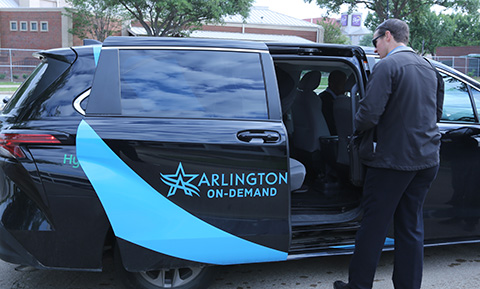
Arlington provides its low-cost, shared, on-demand service through a fleet of more than 70 vehicles, two-thirds of which are hybrid electric. For three to five dollars per trip, users can book a ride in real time within a service area that spans the entire city—a nearly 100-square-mile area—and make connections to a regional rail line and bus service outside the city limits. Passengers can even choose to hail one of the city’s self-driving fleet vehicles, though safety drivers still sit behind the wheel.
Like Uber or Lyft, Arlington On-Demand has no fixed routes, though its “corner-to-corner” service means that passengers may walk a block or two to their pickup spot or destination. And like Uber Pool, passengers will likely share the ride with others who are headed in the same direction. This transportation mode is referred to as “microtransit” or “on-demand transit.” More flexible than a bus, but more energy-efficient than driving a private car, it provides on-demand travel outside the bounds of a fixed route.

The Arlington On-Demand fares are set far lower than better-known rideshare services, helping it to outscore competitors on NREL’s Mobility Energy Productivity (MEP) Tool, which measures how efficiently people can move around an area. Arlington’s service earns high marks for simulating the convenience and ease of driving your own vehicle, despite technically functioning as public transit.
“We are extremely proud that every single person in this city has transit within a block of their origin and destination,” said Alicia Winkelblech, director of Arlington’s transportation department.
The rideshare service’s success in a city that has been resistant to public transit in the past is significant, said NREL’s Stan Young, an advanced transportation and urban scientist who led the technology tour.
“Via Rideshare is the first public-private partnership to provide on-demand rideshare as a city’s sole public transportation option—somewhere that has never had a transit system,” Young said. “This is what we call a ‘greenfield implementation.’ We have a lot to learn from Arlington and their success here.”
Opportunities for the future: One day, Arlington seeks to create additional connections for residents from the city to greater North Central Texas, including the hubs of Dallas and Fort Worth, and to connect to Dallas Fort Worth International Airport. The city aims to convert to fully electrified vehicles and put appropriate charging infrastructure in place, all while maintaining the service’s low cost and flexibility. At some point, the city may also need to consider a few high-frequency, fixed-route services and determine how to integrate them into existing operations.
Second Stop: Dallas, Texas
The second leg of the technology tour took participants to Dallas, Texas, where Dallas Area Rapid Transit (DART) has retrofitted its existing transit system—mostly made up of bus lines and light rail—to connect with on-demand transit. DART is taking a leap toward answering a pivotal question: How does a transit agency integrate on-demand microtransit into existing operations?
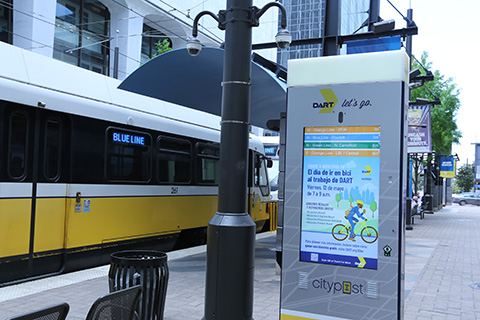
DART serves Dallas and 12 surrounding cities with fully integrated public transit services by seamlessly linking customers to light rail, buses, microtransit, and on-demand ride-hailing through an app called GoPass. Using DART’s online trip planner tool, passengers can type in their origin and destination, customize their route based on transit type, and pay one flat fee for their journey no matter how many different mobility options they use.
For instance, passengers might use GoPass to plan a simple trip: taking a single light rail line from downtown to the airport. But some trips are more complex, involving a transfer from a light rail or bus to microtransit or a rideshare service. In the latter example, while the passenger may take the first leg of their journey by light rail, the GoPass app may match them to a driver through a rideshare service like Uber or Lyft and seamlessly book the next leg of their journey. Ride-pooling is an option, too—the trip may be redirected along the way to add passengers with similar destinations.
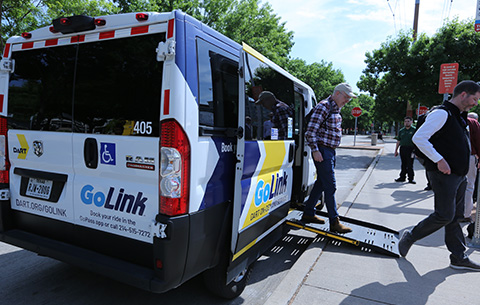
“As far as transit agencies across the U.S. working to integrate on-demand transit, who else is in league with DART?” asked Andy Duvall, one of the NREL researchers on the tour. The answer from Gregory Elsborg, DART’s chief innovation officer: “Nobody.”
Thanks to GoPass, DART has integrated a single point of information and payment for passengers, with a goal of making all its transit modes as easy as other options, like driving a private car or ordering a ride. With over 70% of DART patrons routinely using GoPass and adoption of the app growing, NREL researchers pointed out that it is helping to drive the transition to a concept called “mobility as a service”—where transportation options, and information about how to access them, are so widely available that consumers can shift away from privately-owned vehicles.
“A set of car keys used to represent freedom,” Elsborg said. “Now we’re seeing that a smartphone can accomplish the same thing.”
Opportunities for the future: DART continues to evolve GoPass and GoLink, its on-demand mobility platform. Other municipalities, like Charlotte, North Carolina, and Tulsa, Oklahoma, are adopting similar systems supported by DART’s innovative GoPass technology platform. Further optimizing GoPass, growing its user base, and transitioning DART fleets to fully electric vehicles are promising opportunities for future collaboration.
Third Stop: Phoenix, Arizona
The third leg of the technology tour, Phoenix, was where transportation began to feel straight out of science fiction.
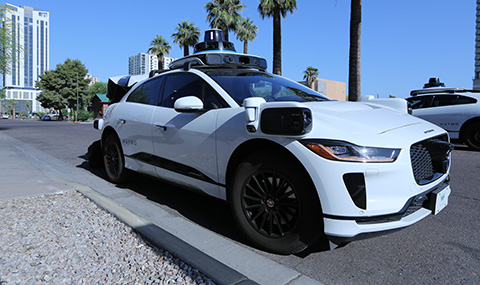
For more than a decade, Waymo—originally known as the Google Self-Driving Car Project—has refined its fully electric, completely driverless “robotaxis.” Now, the company has rolled out the world’s first fully autonomous, electric vehicle ride-hailing service across downtown Phoenix.
Equipped with a powerful suite of sensors, including lidar, radar, and long-range cameras, autonomous Waymo One vehicles—largely made up of Jaguar I-PACE electric SUVs—can perceive people and objects from up to three football fields away, even in the dark, snow, fog, or rain. The software powering the vehicles is billed by Waymo as “the world’s most experienced driver”: It has clocked billions of miles in simulations, 20 million miles on public roads, and zero reported injuries to pedestrians, cyclists, or drivers after driving two million autonomous miles.
Now, the state-of-the-art cars provide on-demand service 24/7 across downtown Phoenix and to and from Phoenix Sky Harbor International Airport. Anyone can fly into Phoenix Sky Harbor International Airport (PHX), download the Waymo One app, and hail a ride.
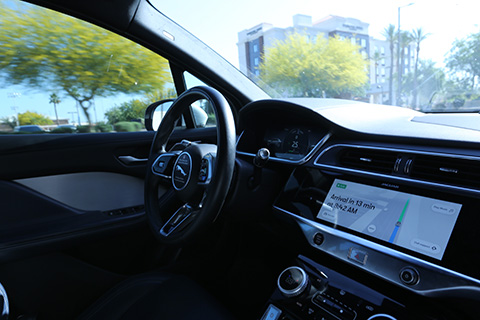
Waymo bills the software powering its self-driving vehicles as “the world’s most experienced driver." Photo by Anna Squires, NREL
As Waymo service expands, it may make car ownership less appealing for those within its service area—another notable expansion of “mobility as a service.”
“Our goal isn’t to put an electric vehicle in your driveway, it’s to bring one to your curb,” said Adam Lenz, Waymo’s head of sustainability and environment. “We hope that the future of transportation will include more walking, cycling, and other kinds of energy-efficient micro-transportation. But when you need a car, you need a car—and it’s great if that car can be fully electric, autonomous, powered by renewable energy, and safe.”
Duvall, an NREL transportation behavior analyst, pointed out that Waymo’s convenience and lower overhead cost might even incentivize some people, especially those who live in dense areas, to reconsider car ownership.
“If this technology could be applied at city scale, it could be a game-changer for public mobility,” Duvall said. “It could create a fundamental realignment of what mobility means for people, especially those who live in suburbs and cities.”
Opportunities for the future: Waymo is in the process of switching its fleet to fully electric cars charged by renewable energy and is working to create a “circular economy” that recycles the cars and their components. Researchers also pointed out opportunities to create further efficiencies, like reducing the amount of power used by vehicles’ sensors, testing out curb management strategies to reduce congestion in crowded areas, and integrating the Waymo autonomous driver software into dedicated shuttles for moving people around airports and hubs for activity.
Final Stop: Phoenix Sky Harbor International Airport
The fourth and final leg of the technology tour was Phoenix Sky Harbor International Airport, or PHX. Because airports move so many people through their facilities, they are frequently at the forefront of new mobility technologies. Or, as Young commented, “Airports are the front door to any modern city and the front line for application of new mobility and information technology.” PHX is no exception.
For instance, PHX recently led a charge to take significant traffic off its roadway system by expanding its people mover, called Sky Train, to take passengers all the way to the airport’s rental car facility. PHX also facilitated a partnership with Waymo to make Phoenix the first American city served by fully autonomous vehicles.
Just as airports are hubs for emerging technologies, they can also illustrate how cities and regions can overcome transportation challenges.
“PHX is a small city unto itself,” said Jennifer Maples, PHX’s asset management and sustainability programs administrator.
The airport, she explained, has traffic issues, parking challenges, sustainability goals, and customer expectations to manage while implementing new infrastructure and technology. As the world asks what the future of sustainable transportation might look like, seeing airports overcome transportation challenges—like integrating renewable energy sources into existing systems or efficiently moving people through large facilities—can help create road maps for others to follow.
Opportunities for the future: During the technology tour, PHX leadership and NREL researchers discussed several potential future opportunities for the airport, including electrification, traffic management, curbside management, meeting the needs of people with reduced mobility, and managing growth—and doing so within the scope of the airport’s sustainability goals. All these areas are ripe opportunities for collaboration.
Sustainable Transportation of the Future
NREL’s transportation researchers come back to a fundamental question again and again: What will the future of sustainable transportation look like? Will it revolve around electric travel? Autonomous? On-demand? How much of it will rely on private car ownership, and how much will see travelers using other options, like microtransit and shared rides?
Only time will tell. For now, those researchers, plus airports and public transit agencies across the country, are hard at work shaping the sustainable transportation of the future—so it can become a reality for tomorrow.
Learn more about NREL's sustainable transportation and mobility research, including a specific focus on sustainable mobility systems. And sign up for NREL's quarterly transportation and mobility research newsletter, Sustainable Mobility Matters, to get the latest news.
Last Updated May 28, 2025
